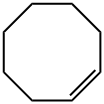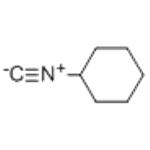Purification Methods
The cis-isomer is freed from the trans-isomer by fractional distillation through a spinning-band column, followed by preparative gas chromatography on a Dowex 710-Chromosorb W GLC column. It is passed through a short alumina column immediately before use [Collman et al. J Am Chem Soc 108 2588 1986]. It has also been distilled in a dry N2 glove box from powdered fused NaOH through a Vigreux column (p 11), then passed through activated neutral alumina before use [Wong et al. J Am Chem Soc 109 4328 1987]. Alternatively it can be purified via the AgNO3 salt. This salt is obtained from crude cyclooctene (40 mL) by shaking at 70-80o with 50% w/w AgNO3 (2 x 15 mL) to remove cyclooctadienes (aqueous layer). Extraction is repeated at 40o (4 x 20 mL, of 50% AgNO3). Three layers are formed each time. The middle layer contains the AgNO3 adduct of cyclooctene which crystallises on cooling the layer to room temperature. The adduct (complex 2:1) is highly soluble in MeOH (at least 1g/mL) from which it crystallises in large flat needles when cooled at 0o. It is dried under slight vacuum for 1 week in the presence of CaCl2 and paraffin wax soaked in cyclooctene. It has m 51o and loses hydrocarbon on exposure to air. cis-Cyclooctene can be recovered by steam distillation of the salt, collected, dried (CaCl2) and distilled in vacuum. [Braude et al. J Chem Soc 4711 1957, AgNO3: Jones J Chem Soc 1808 1954, Cope & Estes J Am Chem Soc 72 1128 1950, Beilstein 5 I 35, 5 IV 263.] FLAMMABLE LIQUID.





